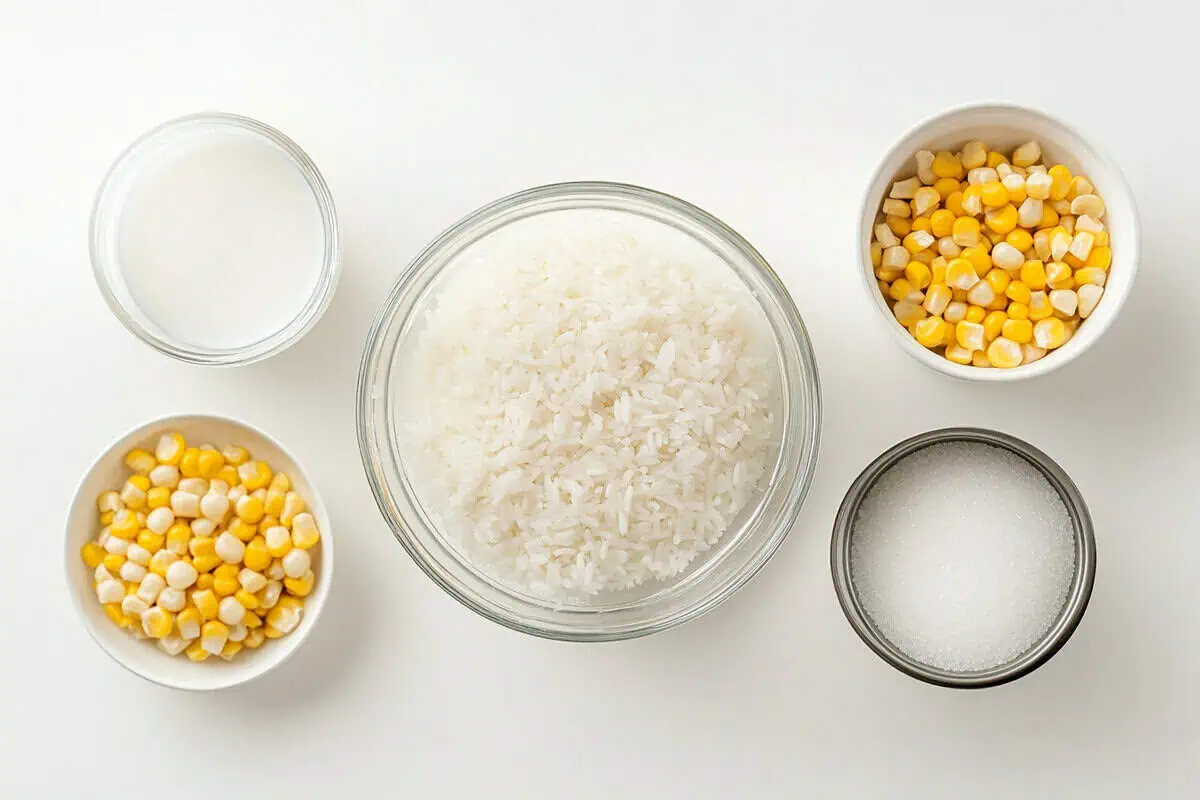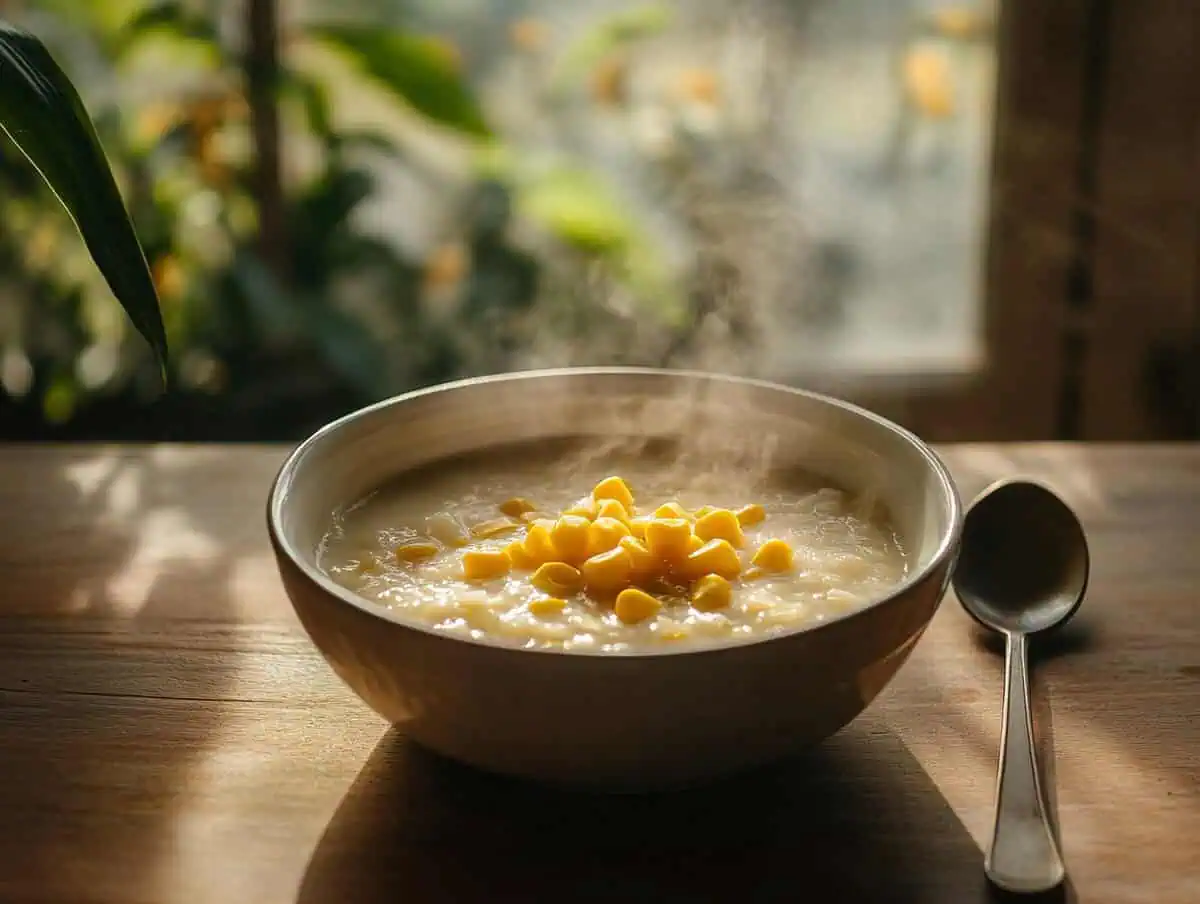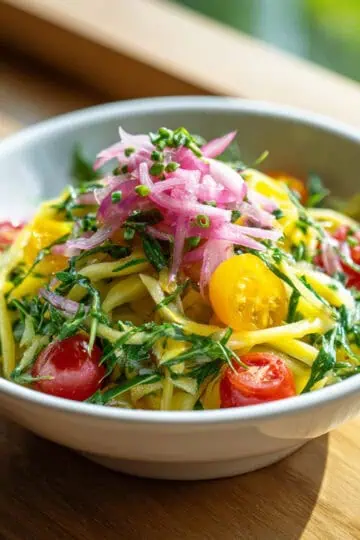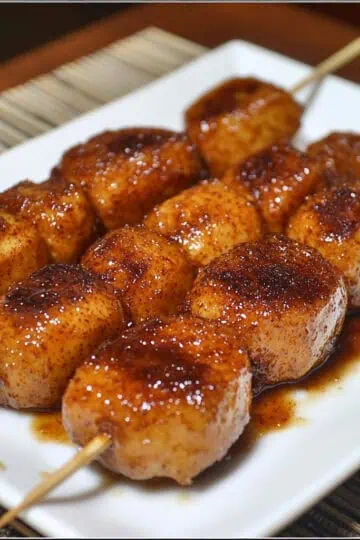Welcome to Kusina Secrets! Today I'm sharing my absolute favorite Ginataang Mais recipe that has been passed down through generations in my family. This creamy Filipino coconut corn pudding has the perfect balance of sweetness from the corn, richness from the coconut milk, and a comforting texture from the glutinous rice that makes it irresistible.
After years of perfecting this recipe, I've made it so simple that anyone can create this authentic Filipino comfort food in under 30 minutes with just 4 ingredients. Whether you're craving a satisfying breakfast, an afternoon snack, or a warm dessert, this Ginataang Mais will quickly become your go-to recipe.
Keep reading to discover how easy it is to bring this beloved Filipino classic to your own table.
What is Ginataang Mais?
Ginataang Mais (pronounced gee-na-ta-ang ma-ees) is a traditional Filipino dessert or snack made from whole kernel corn, glutinous rice, and coconut milk. The term "ginataan" refers to any Filipino dish cooked in coconut milk, while "mais" means corn. Unlike other Filipino desserts like Maja Blanca which has a firm texture, Ginataang Mais has a porridge-like consistency similar to Goto, Arroz Caldo, or Champorado.
Jump to:
Why You'll Love This Recipe
- Simple Ingredients: Requires just 4 basic ingredients you might already have in your pantry
- Quick Preparation: Ready to enjoy in less than 30 minutes
- Versatile: Perfect as a breakfast, snack, or dessert
- Naturally Gluten-Free: Great for those with dietary restrictions
- Comforting Texture: The perfect balance of creamy and chewy textures
- Energy-Boosting: Rich in carbohydrates to fuel your day
Ingredients
I've carefully selected these four simple ingredients to create the perfect Ginataang Mais. The coconut milk provides a rich, creamy base that's quintessentially Filipino. The glutinous rice gives that comforting, chewy texture that makes this dish so satisfying. Sweet corn adds natural sweetness and a pop of flavor in every bite.
Finally, just enough sugar enhances all these flavors without overwhelming them. These ingredients work together beautifully while keeping this traditional recipe authentic and accessible for everyone.

- 4 cups coconut milk
- ½ cup glutinous rice (malagkit)
- 1 cup whole kernel corn (fresh or canned)
- ¾ cup granulated sugar
Equipment
- Medium-sized cooking pot
- Wooden spoon or heat-resistant spatula
- Measuring cups
- Serving bowls

How To Make
- Combine coconut milk and glutinous rice in a cooking pot and place over medium heat. Bring the coconut milk to a gentle boil.
- Once boiling, reduce heat to low and stir the mixture regularly to prevent the glutinous rice from sticking to the bottom of the pot. Continue cooking until the rice is tender, approximately 12-15 minutes.
- Add the whole kernel corn and cook for an additional 5 minutes, stirring occasionally.
- Stir in the sugar until completely dissolved. Cook for 2 more minutes to allow the flavors to meld together.
- Transfer to serving bowls and enjoy warm or chilled.

Tips from Lola's Kitchen
- For creamier results: Use fresh coconut milk rather than canned whenever possible
- Perfect rice texture: Wash the glutinous rice thoroughly before cooking to remove excess starch
- Sweet corn tip: When in season, use fresh sweet corn kernels cut directly from the cob for the best flavor
- Stirring technique: Stir frequently but gently to prevent the rice from sticking while maintaining a nice texture
- Sweetness control: Adjust the sugar to your preference - some prefer it less sweet to appreciate the natural corn flavor
- Serving suggestion: Try topping with a small sprinkle of toasted coconut flakes for added texture
Substitutions
- Coconut milk alternative: You can use a combination of coconut cream diluted with water if coconut milk isn't available
- Rice options: Regular white rice can be used instead of glutinous rice, though the texture will be different
- Sugar alternatives: Brown sugar, palm sugar, or honey can be substituted for granulated sugar (adjust quantities to taste)
- Corn variations: Sweet cream-style corn can be used for a smoother texture
- Dairy addition: For a fusion twist, some cooks add a small amount of condensed milk for extra richness
Troubleshooting
- Too thick? Add a splash of water or additional coconut milk and stir well
- Too thin? Continue cooking until it reaches your desired consistency, as it will naturally thicken as it cools
- Rice not cooking? Ensure you're using low heat and giving it enough time - different rice varieties may need longer cooking times
- Too sweet? Balance with a squeeze of lime juice or a pinch of salt
- Not sweet enough? Add more sugar one tablespoon at a time until desired sweetness is reached
Storage & Reheating
- Refrigeration: Store leftover Ginataang Mais in an airtight container in the refrigerator for up to 3 days
- Freezing: Not recommended as the texture significantly changes upon thawing
- Reheating: Warm gently in a saucepan over low heat, adding a small amount of coconut milk or water to loosen the consistency
- Cold option: Some prefer Ginataang Mais chilled, especially during hot weather

FAQ
Can I make Ginataang Mais ahead of time?
Yes, you can prepare it a day in advance. It may thicken when refrigerated, so you might need to add a bit of coconut milk when reheating.
Is Ginataang Mais healthy?
While it contains natural ingredients, it is relatively high in carbohydrates and sugar. It's best enjoyed in moderation as part of a balanced diet.
Can I reduce the sugar?
Absolutely! The sugar can be adjusted to your taste preference without affecting the texture.
What's the difference between Ginataang Mais and Champorado?
While both have similar porridge-like textures, Champorado is made with chocolate and rice, while Ginataang Mais features corn and coconut milk.
Can I add other ingredients?
Yes! Some variations include adding small tapioca pearls, jackfruit strips, or a dash of vanilla extract for extra flavor.
Is this dish vegan?
Yes, the traditional recipe is naturally vegan as it contains only plant-based ingredients.
Can I use frozen corn?
Yes, frozen corn works well. Just thaw it before adding to the pot.
Why is my Ginataang Mais watery?
It might need more cooking time to thicken. Remember that it will continue to thicken as it cools.
Related
Looking for other recipes like this? Try these:

Ginataang Mais
Ingredients
- 4 cups coconut milk
- ½ cup glutinous rice malagkit
- 1 cup whole kernel corn fresh or canned
- ¾ cup granulated sugar
Instructions
- Combine coconut milk and glutinous rice in a cooking pot and place over medium heat. Bring the coconut milk to a gentle boil.
- Once boiling, reduce heat to low and stir the mixture regularly to prevent the glutinous rice from sticking to the bottom of the pot. Continue cooking until the rice is tender, approximately 12-15 minutes.
- Add the whole kernel corn and cook for an additional 5 minutes, stirring occasionally.
- Stir in the sugar until completely dissolved. Cook for 2 more minutes to allow the flavors to meld together.
- Transfer to serving bowls and enjoy warm or chilled.
Tips from Lola's Kitchen
- For creamier results: Use fresh coconut milk rather than canned whenever possible
- Perfect rice texture: Wash the glutinous rice thoroughly before cooking to remove excess starch
- Sweet corn tip: When in season, use fresh sweet corn kernels cut directly from the cob for the best flavor
- Stirring technique: Stir frequently but gently to prevent the rice from sticking while maintaining a nice texture
- Sweetness control: Adjust the sugar to your preference - some prefer it less sweet to appreciate the natural corn flavor
- Serving suggestion: Try topping with a small sprinkle of toasted coconut flakes for added texture
The Story Behind Ginataang Mais
Ginataang Mais holds a special place in Filipino culinary tradition, dating back generations as a humble yet beloved dish found throughout the Philippines. This sweet corn and coconut milk porridge emerged from the agricultural abundance of the islands, where both corn and coconuts grow plentifully in the tropical climate. Filipino farmers would often prepare this energy-rich dish during harvest seasons, using freshly picked corn and newly pressed coconut milk from local trees.
What makes Ginataang Mais truly special is how it exemplifies the Filipino "ginataan" cooking technique—the practice of simmering ingredients in coconut milk until they create a harmonious blend of flavors and textures. This method appears throughout Filipino cuisine, from savory dishes to sweet treats, but the combination with corn creates something uniquely comforting.
In Filipino households, Ginataang Mais often represents childhood memories of afternoon merienda (snack time) when grandmothers or mothers would prepare this warm, sweet porridge as an after-school treat. The dish crosses socioeconomic boundaries, appearing on tables in rural farming communities and urban homes alike, showcasing the democratic nature of Filipino comfort food.
While regional variations exist across the 7,000+ islands of the Philippines—some adding jackfruit, sago pearls, or even sweet potato—the core elements remain consistent: corn, glutinous rice, coconut milk, and sweetener. This simplicity is precisely what makes traditional Ginataang Mais so beloved and enduring in Filipino food culture.
Today, as Filipino cuisine gains global recognition, Ginataang Mais represents the perfect introduction to the country's unique approach to comfort food—dishes that are straightforward to prepare yet complex in their cultural significance and ability to provide nourishment for both body and soul. This recipe honors that tradition while making it accessible to anyone wanting to experience authentic Filipino flavors at home.










Comments
No Comments